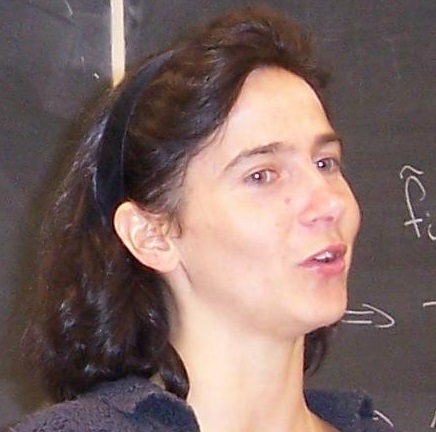7.2: Eigenvalues
( \newcommand{\kernel}{\mathrm{null}\,}\)
Definition 7.2.1. Let T in L(V,V). Then λ in F is an eigenvalue of T if there exists a nonzero vector u∈V such that
Tu=λu.
The vector u is called an eigenvector of T corresponding to the eigenvalue λ.
Finding the eigenvalues and eigenvectors of a linear operator is one of the most important problems in Linear Algebra. We will see later that this so-called ``eigen-information'' has many uses and applications. (As an example, quantum mechanics is based upon understanding the eigenvalues and eigenvectors of operators on specifically defined vector spaces. These vector spaces are often infinite-dimensional, though, and so we do not consider them further in these notes.)
Example 7.2.2.
- Let T be the zero map defined by T(v)=0 for all v∈V. Then every vector u≠0 is an eigenvector of T with eigenvalue 0.
- Let I be the identity map defined by I(v)=v for all v∈V. Then every vector u≠0 is an eigenvector of T with eigenvalue 1.
- The projection map P:R3→R3 defined by P(x,y,z)=(x,y,0) has eigenvalues 0 and 1. The vector (0,0,1) is an eigenvector with eigenvalue 0, and both (1,0,0) and (0,1,0) are eigenvectors with eigenvalue 1.
- Take the operator R:F2 to F2 defined by R(x,y)=(−y,x). When F=R,
R can be interpreted as counterclockwise rotation by 900. From this interpretation, it is clear that no non-zero vector in R2 is mapped to a scalar multiple of itself. Hence, for F=R, the operator R has no eigenvalues.
For F=C, though, the situation is significantly different! In this case, λ∈C is an eigenvalue of R if
R(x,y)=(−y,x)=λ(x,y)
so that y=−λx and x=λy. This implies that y=−λ2y, i.e., that λ2=−1. The solutions are hence λ=±i. One can check that (1,−i) is an eigenvector with eigenvalue i and that (1,i) is an eigenvector with eigenvalue −i.
Eigenspaces are important examples of invariant subspaces. Let T∈L(V,V), and let λ∈F be an eigenvalue of T. Then
Vλ={v∈V∣Tv=λv}
is called an eigenspace of T. Equivalently,
Vλ=null(T−λI).
Note that Vλ≠{0} since λ is an eigenvalue if and only if there exists a nonzero vector u in V such that Tu=λu. We can reformulate this as follows:
λ∈F is an eigenvalue of T if and only if the operator T−λI is not injective.
Since the notion of injectivity, surjectivity, and invertibility are equivalent for operators on a finite-dimensional vector space, we can equivalently say either of the following:
- λ∈F is an eigenvalue of T if and only if the operator T−λI is not surjective.
- λ∈F is an eigenvalue of T if and only if the operator T−λI is not invertible.
We close this section with two fundamental facts about eigenvalues and eigenvectors.
Theorem 7.2.3. Let T∈L(V,V), and let λ1,…,λm∈F be m distinct eigenvalues of T with corresponding nonzero eigenvectors v1,…,vm. Then (v1,…,vm) is linearly independent.
Proof. Suppose that (v1,…,vm) is linearly dependent. Then, by the Linear Dependence Lemma, there exists an index k∈{2,…,m} such that
vk∈span(v1,…,vk−1)
and such that (v1,…,vk−1) is linearly independent. This means that there exist scalars a1,…,ak−1 in F such that
vk=a1v1+⋯+ak−1vk−1.
Applying T to both sides yields, using the fact that vj is an eigenvector with eigenvalue λj,
λkvk=a1λ1v1+⋯+ak−1λk−1vk−1.
Subtracting λk times Equation (7.2.1) from this, we obtain
0=(λk−λ1)a1v1+⋯+(λk−λk−1)ak−1vk−1.
Since (v1,…,vk−1) is linearly independent, we must have (λk−λj)aj=0 for all j=1,2,…,k−1. By assumption, all eigenvalues are distinct, so λk−λj≠0, which implies that aj=0 for all j=1,2,…,k−1. But then, by Equation (7.2.1), vk=0, which contradicts the assumption that all eigenvectors are nonzero. Hence (v1,…,vm) is linearly independent.
Corollary 7.2.4. Any operator T∈L(V,V) has at most dim(V) distinct eigenvalues.
Proof. Let λ1,…,λm be distinct eigenvalues of T, and let v1,…,vm be corresponding nonzero eigenvectors. By Theorem 7.2.3, the list (v1,…,vm) is linearly independent. Hence m≤dim(V).
Contributors
- Isaiah Lankham, Mathematics Department at UC Davis
- Bruno Nachtergaele, Mathematics Department at UC Davis
- Anne Schilling, Mathematics Department at UC Davis
Both hardbound and softbound versions of this textbook are available online at WorldScientific.com.


